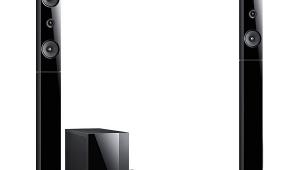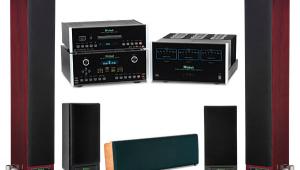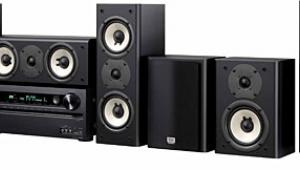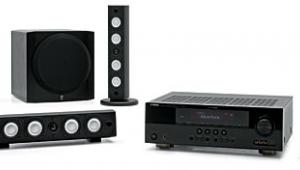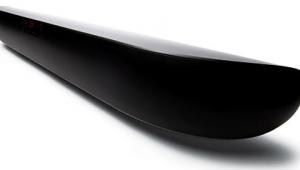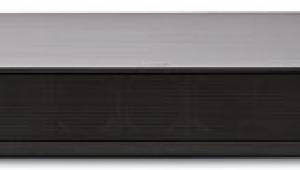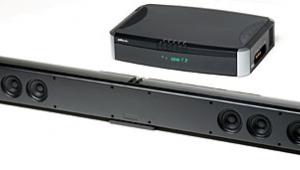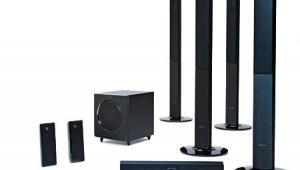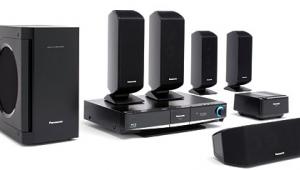JVC TH-F3 DVD Digital Theater System Page 2
This trend continued in The Counterfeiters. The film includes a Berlin nightclub scene that’s atmospheric but not enveloping. However, the system did avoid thinness—male vocals were reasonably proportionate. Harmonica, an instrument that normally shreds eardrums, didn’t sound harsh. Some bass effects were too strong, and I wished the system (and its narrow sub adjustment range) would have allowed me to turn them down a little more.
Shine a Light is the Martin Scorsese/Rolling Stones concert film, recorded live at New York’s Beacon Theater. The old, sleazy venue is perfect for these lovable survivors. Guitars got an excitingly zingy top end. The mix doesn’t allow much of a drum sound—the bonus tracks actually have a better bottom end than the main ones. When the audience bursts into applause, once again the system was not as “you-are-there” as I’d hoped.
 Fun with Listening Modes
Fun with Listening Modes
My musical selections were from CDs. I used Peace and Love by the Pogues as a platform to experiment with sound modes. Steve Lillywhite’s production of the folk-rock colossus turned the chiming mandolin, banjo, penny whistle, accordion, and other traditional instruments into a Celtic wall of sound. What happened next depended on what mode I chose. The system offers four modes: Auto Surround, Movie, Wide/2-Channel, and Super Wide. The latter three modes use Dolby Pro Logic II processing, so the Movie mode is the DPLII movie mode. The two wide-ish modes probably represent the Music mode with other DPLII tweaks. This system doesn’t include the usual panoply
of DPLII user adjustments (center width, panorama, etc.), presumably because they are embodied in the JVC-designed modes.
Auto Surround (in a CD context, stereo) added the least processing but still revealed the system’s modest and not unpleasant midrange coloration. I skipped over the Movie mode, since none of my demo material used analog Dolby Surround. The Wide/2-Channel mode was the most striking. It widened and deepened the soundstage. It also sounded a bit spacey and synthetic, especially in its treatment of drum reverb. The Super Wide setting disappointed me. Everything sounded distant, as though the system had been locked in a closet. The highlight was “Down All the Days,” one of my favorite Shane MacGowan songs. The song uses tapping typewriter effects and a ferocious drone to add up to a kind of Irish psychedelia.
Bill Bruford’s Earthworks weighed in with A Part, and Yet Apart. Here, the system surprised me by rendering this naturalistic jazz recording, well, naturally. The saxophone didn’t exacerbate the system’s coloration as much as the Pogues’ toppy instruments did. Bruford’s snare, always mixed forward in this drummer-led band, had the right snap. While the bass drum and string bass revealed the sub’s limits, they at least got a solidly competent treatment. The sub’s small driver was controlled enough not to bloat unduly. This demo improved my opinion of the system—I could see using it in my bedroom.
The system got a piano and orchestra workout with Beethoven: The Piano Concertos by Vladimir Ashkenazy and the Chicago Symphony with Sir Georg Solti. I concentrated on the fifth (Emperor) concerto. Again, the Auto Surround (stereo) and Wide/2-Channel modes were the most listenable. I eventually favored the latter for its fluffier string sound. The sub best conveyed the piano’s lower registers in the center of its volume range.
iPod Docking and Channel Checks
When the demos were over, I played with the iPod interface. The system remote can navigate menus and transport controls on the iPod. However, it does not provide an onscreen display for iPod use. You’ve got to use the iPod’s own screen, which can be hard to see from across the room.
My final test was the 5.1-channel check from the Avia test DVD. The front left and right channels came from their respective speakers. A phantom center image floated between the speakers. When I moved my head even slightly off axis, the center image became localizable in the side toward which I was leaning. The big question, of course, was how the system produced the surround channels with only two speakers in front. Each signal (both surround-left and surround-right) emerged from both speakers, less than a foot forward of the speakers. And each one was localizable between the speakers, with virtually no steering (that I could hear) to indicate left or right. The surround channels provided a bigger, less spatially precise sound than the front channels, possibly due to different phase characteristics.
The JVC TH-F3 is a mixed bag. For a $500 system, it looks spiffy. The speakers’ build quality is commendable. The subwoofer also performs better than I’d expect in a system at this price. But JVC’s method of producing surround-like effects from two speakers doesn’t work as well as other systems I’ve heard—especially those that use Dolby’s proprietary version of Virtual Surround. If you adjust your expectations and recategorize this as a 2.1-channel system, you’ll less likely be disappointed. Consider it for your summer cabin, kid’s room, or guest bedroom.
- Log in or register to post comments
